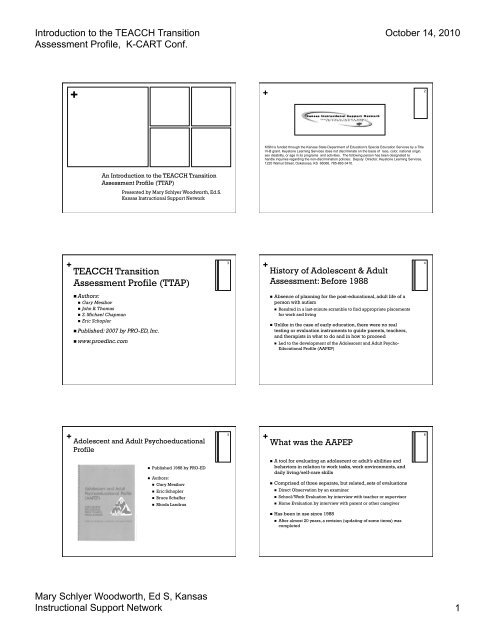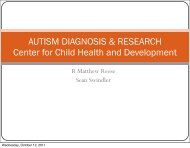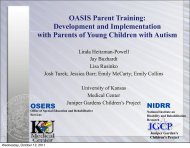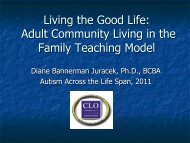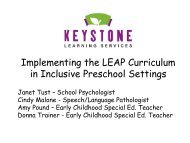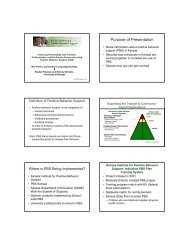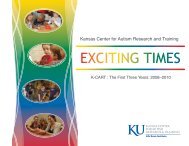Presentation - The Kansas Center for Autism Research and Training
Presentation - The Kansas Center for Autism Research and Training
Presentation - The Kansas Center for Autism Research and Training
You also want an ePaper? Increase the reach of your titles
YUMPU automatically turns print PDFs into web optimized ePapers that Google loves.
Introduction to the TEACCH Transition<br />
Assessment Profile, K-CART Conf.<br />
October 14, 2010<br />
+<br />
+<br />
2<br />
KISN is funded through the <strong>Kansas</strong> State Department of Education's Special Education Services by a Title<br />
VI-B grant. Keystone Learning Services does not discriminate on the basis of race, color, national origin,<br />
sex disability, or age in its programs <strong>and</strong> activities. <strong>The</strong> following person has been designated to<br />
h<strong>and</strong>le inquiries regarding the non-discrimination policies: Deputy Director, Keystone Learning Services,<br />
1220 Walnut Street, Oskaloosa, KS 66066, 785-863-3410.<br />
An Introduction to the TEACCH Transition<br />
Assessment Profile (TTAP)<br />
Presented by Mary Schlyer Woodworth, Ed.S.<br />
<strong>Kansas</strong> Instructional Support Network<br />
+ TEACCH Transition<br />
Assessment Profile (TTAP)<br />
3<br />
+ History of Adolescent & Adult<br />
Assessment: Be<strong>for</strong>e 1988<br />
4<br />
Authors:<br />
Gary Mesibov<br />
John B. Thomas<br />
S. Michael Chapman<br />
Eric Schopler<br />
Published: 2007 by PRO-ED, Inc.<br />
www.proedinc.com<br />
Absence of planning <strong>for</strong> the post-educational, adult life of a<br />
person with autism<br />
Resulted in a last-minute scramble to find appropriate placements<br />
<strong>for</strong> work <strong>and</strong> living<br />
Unlike in the case of early education, there were no real<br />
testing or evaluation instruments to guide parents, teachers,<br />
<strong>and</strong> therapists in what to do <strong>and</strong> in how to proceed<br />
Led to the development of the Adolescent <strong>and</strong> Adult Psycho-<br />
Educational Profile (AAPEP)<br />
+ Adolescent <strong>and</strong> Adult Psychoeducational<br />
5<br />
+ What was the AAPEP<br />
6<br />
Profile<br />
Published 1988 by PRO-ED<br />
Authors:<br />
Gary Mesibov<br />
Eric Schopler<br />
Bruce Schaffer<br />
Rhoda L<strong>and</strong>rus<br />
A tool <strong>for</strong> evaluating an adolescent or adult’s abilities <strong>and</strong><br />
behaviors in relation to work tasks, work environments, <strong>and</strong><br />
daily living/self-care skills<br />
Comprised of three separate, but related, sets of evaluations<br />
Direct Observation by an examiner<br />
School/Work Evaluation by interview with teacher or supervisor<br />
Home Evaluation by interview with parent or other caregiver<br />
Has been in use since 1988<br />
After almost 20 years, a revision (updating of some items) was<br />
completed<br />
Mary Schlyer Woodworth, Ed S, <strong>Kansas</strong><br />
Instructional Support Network 1
Introduction to the TEACCH Transition<br />
Assessment Profile, K-CART Conf.<br />
October 14, 2010<br />
+ Revised AAPEP becomes the TTAP<br />
7<br />
+ Rationale <strong>for</strong> using the TTAP<br />
8<br />
TEACCH Transition Assessment Profile<br />
Authors:<br />
Gary Mesibov<br />
John B. Thomas<br />
S. Michael Chapman<br />
Eric Schopler<br />
Published: 2007 by<br />
PRO-ED, Inc.<br />
www.proedinc.com<br />
Addresses the Requirements of US Law:<br />
Comprehensive Formal Assessment by age 14-16 (few<br />
instruments <strong>for</strong> students with ASD)<br />
Addresses Principal Transition Areas<br />
Identifies Strengths <strong>and</strong> Interests<br />
Assessment Across Contexts:<br />
Family <strong>and</strong> School as well as Vocational<br />
Provides goals <strong>for</strong> IEP/ITP related to postsecondary<br />
outcomes<br />
+ Rationale <strong>for</strong> using the TTAP (2)<br />
9<br />
Addresses the requirements of IDEA:<br />
Provides a method <strong>for</strong> ongoing In<strong>for</strong>mal<br />
Assessment<br />
Provides “Structure Checklist” to assess student’s<br />
abilities to use visual cues<br />
+ TEACCH Transition<br />
Assessment Profile (TTAP)<br />
Formal Assessment<br />
10<br />
+ TTAP Formal Assessment<br />
11<br />
+ Scoring<br />
12<br />
What it is:<br />
Same <strong>for</strong>mal assessment instrument as the AAPEP<br />
Updated <strong>and</strong> exp<strong>and</strong>ed to include more high-functioning<br />
skills in recognition of increasing incidence of highfunctioning<br />
autism diagnoses<br />
Controlled administration, yet flexible assessment of<br />
learning patterns<br />
Function<br />
Determine relative strengths <strong>and</strong> needs <strong>for</strong> adult living<br />
Same scoring system as used in Psycho-<br />
Educational Profile – 3 (PEP-3)<br />
Pass (skill or trait present)<br />
Emerge (skill or trait partially present; can be taught)<br />
Fail (skill or trait not present <strong>and</strong> not likely to be acquirable<br />
at this time)<br />
Environmental support may be required <strong>for</strong> these skills<br />
or traits (see Structure Checklist <strong>for</strong> ideas)<br />
Foundation <strong>for</strong> transition education (aims at ages 10-15)<br />
Mary Schlyer Woodworth, Ed S, <strong>Kansas</strong><br />
Instructional Support Network 2
Introduction to the TEACCH Transition<br />
Assessment Profile, K-CART Conf.<br />
October 14, 2010<br />
+ Advantages of using the TTAP<br />
Formal Assessment<br />
13<br />
+ Advantages of using the TTAP<br />
Formal Assessment (2)<br />
14<br />
Broader array of items - Aims at Severe to Mild<br />
Intellectual Deficiency <strong>and</strong> ASD – 216 items<br />
Methods of teaching new skills built into test as a<br />
means of identifying strategies <strong>for</strong> instruction<br />
Comprehensive Formal Assessment (few<br />
instruments <strong>for</strong> students with ASD)<br />
Non-verbal <strong>and</strong> verbal instructions<br />
Flexible time limits<br />
Flexible order of presentation<br />
Identifies Strengths <strong>and</strong> Interests<br />
Assessment Across 3 Contexts:<br />
Direct Observation of Student,<br />
Family/Home <strong>and</strong><br />
School/Work<br />
Pass, Emerge, Fail Scoring<br />
Goal Development from Emerging Skills<br />
+ Advantages of using the TTAP<br />
Formal Assessment (3)<br />
15<br />
+ Direct Observation Scale<br />
16<br />
Each Context is Assessed in the same six<br />
functional/transition areas<br />
Vocational skills<br />
Vocational behaviors<br />
Independent functioning<br />
Leisure skills<br />
Functional Communication<br />
Interpersonal Behavior<br />
<strong>The</strong> items of the Direct Observation Scale are<br />
presented in a general order that should assist<br />
effective administration<br />
<strong>The</strong> order of administration may vary in<br />
accordance with the needs or behavioral<br />
characteristics of the individual<br />
Certain items within the test are clustered (or<br />
presented together) <strong>for</strong> efficient administration<br />
+ Length<br />
17<br />
+ Direct Observation Scale: Vocational<br />
18<br />
Skills<br />
<strong>The</strong> Direct Observation Scale is administered by a<br />
psychologist, teacher who is unfamiliar to the<br />
student, or other trained professional, in a clinical<br />
setting<br />
This portion of the assessment should take one <strong>and</strong><br />
one half, to two hours to complete but time may<br />
vary depending upon the individuals level of<br />
functioning <strong>and</strong> rate of response<br />
Sorting<br />
Correcting Sorting Errors<br />
Matching to Jig<br />
Matching/Sorting Colors<br />
Sorting <strong>and</strong> Collating<br />
Uses One-to-One<br />
Correspondence to<br />
Complete 3-Step Task<br />
Travel Kit Assembly<br />
Simple <strong>and</strong> Sophisticated<br />
Alphabetizing<br />
Measuring with Ruler<br />
Filing by Number<br />
Measuring with Cups <strong>and</strong><br />
Spoons<br />
Typing<br />
Mary Schlyer Woodworth, Ed S, <strong>Kansas</strong><br />
Instructional Support Network 3
Introduction to the TEACCH Transition<br />
Assessment Profile, K-CART Conf.<br />
October 14, 2010<br />
+ 7. Travel Kit<br />
19<br />
+ Travel Kit with Photos<br />
20<br />
Materials: 6 each of travel size soaps, shampoos, lotions, toothbrushes,<br />
<strong>and</strong> tubes of toothpaste; 6 of a “decoy” item (powder); bins <strong>for</strong> each item<br />
<strong>and</strong> zip lock bags; a photograph of the assembled product (actual size), a<br />
photograph jig or outline/silhouette jig displaying the bag <strong>and</strong> all items to<br />
be packaged in the bag, <strong>and</strong> a basket or box <strong>for</strong> finished items (stopwatch<br />
<strong>for</strong> timing)<br />
Procedure: Place the 6 sets of items in separate containers in front of the<br />
individual in a left to right sequence bags on the left <strong>and</strong> the photograph<br />
of the assembled product to the right side of the individual with the<br />
finished basket. Place the decoy item in the middle of the other 5 items<br />
portrayed in the jigs <strong>and</strong> photograph. Tell the individual to make a kit just<br />
like the one in the photograph. If the individual makes two or more errors<br />
in the first assembly, place the silhouette jigs in front of the individual, <strong>and</strong><br />
the box <strong>for</strong> finished items to the right of the individual, with the<br />
photograph of the assembled product in front of the box. If unsuccessful,<br />
repeat this procedure with the photograph jigs. Indicate to the individual<br />
to match each item to the matching picture in the photograph. When he/<br />
she matches all items, then indicate to assemble the items as in the second<br />
photograph <strong>and</strong> put in the box.<br />
+ 7. Travel Kit<br />
21<br />
Scoring:<br />
Passing — Assembles 5 sets (either be<strong>for</strong>e or after<br />
photograph jig presented) within 5 minutes with no<br />
more than 3 errors.<br />
Emerging — Matches at least 2 items to the jig but does<br />
not complete the assembly within 5 minutes.<br />
Failing — Fewer than 2 items placed correctly.<br />
+<br />
Interview Scales:<br />
Family/Home<br />
22<br />
+ Home Scales<br />
23<br />
+ Home Scale: Vocational Skills<br />
24<br />
Involves an interview with either the individual’s<br />
parents or residential supervisor<br />
Scoring System: Pass, Emerge, Fail<br />
Should take approximately an hour to complete<br />
Simple Workshop/Kitchen/<br />
Desk tools<br />
Sorts Everyday Items<br />
Sweeps or Vacuums<br />
Uses Cleaning Tools<br />
Washes <strong>and</strong> Dries Clothes<br />
Washes <strong>and</strong> Dries Dishes<br />
Uses Kitchen Appliances<br />
Folds Towels<br />
Makes Bed<br />
Unloads Dishwasher <strong>and</strong><br />
Puts Away Dishes<br />
Sets Table<br />
Cleans up after meal or<br />
cooking<br />
Mary Schlyer Woodworth, Ed S, <strong>Kansas</strong><br />
Instructional Support Network 4
Introduction to the TEACCH Transition<br />
Assessment Profile, K-CART Conf.<br />
October 14, 2010<br />
+ 77. Washes <strong>and</strong> Dries Clothes<br />
25<br />
Passing — Uses washing machine <strong>and</strong> dryer<br />
adequately without supervision or after one<br />
demonstration.<br />
Emerging — Needs occasional assistance or<br />
repeated demonstrations to use washing<br />
machine or dryer adequately.<br />
+<br />
Interview Scales:<br />
School/Work<br />
Failing — Does not use washing machine or<br />
dryer without constant guidance.<br />
26<br />
+ Length<br />
27<br />
Involves an interview with either the individual’s<br />
teachers or work supervisor<br />
Scoring System: Pass, Emerge, Fail<br />
Should take approximately an hour to complete<br />
+ School/Work Scale: Vocational<br />
Skills<br />
Sorts Objects<br />
Follows Assembly Diagram<br />
Files by Matching Symbols<br />
Uses Simple Machines <strong>and</strong><br />
Tools<br />
Discriminates by Size<br />
Measures<br />
Packages Objects<br />
Cleans Own Work Area<br />
Fills Containers to Rim<br />
Uses List to Retrieve Items<br />
From a Shelf<br />
Operates Equipment in<br />
Response to Gauge, Timer,<br />
Buttons<br />
Lifts <strong>and</strong> Moves Items<br />
28<br />
+ 153. Fills Containers to Rim<br />
29<br />
Passing - When pouring (e.g., filling salt shakers,<br />
filling glasses <strong>for</strong> snack, pouring foodstuffs into<br />
containers, etc.), fills each container to within ½<br />
inch or rim without over-filling or under-filling<br />
container, <strong>and</strong> spills only rarely.<br />
Emerging — Inconsistently over-fills or under-fills<br />
containers or occasionally spills when pouring.<br />
Failing - Frequently spills when pouring or<br />
consistently over-fills or under-fills containers.<br />
+<br />
Interpretation of Results<br />
Profile/Scoring Form<br />
30<br />
Mary Schlyer Woodworth, Ed S, <strong>Kansas</strong><br />
Instructional Support Network 5
Introduction to the TEACCH Transition<br />
Assessment Profile, K-CART Conf.<br />
October 14, 2010<br />
+ Recording Scores <strong>and</strong> Structure<br />
31<br />
+ Scores Profile<br />
32<br />
Checklist<br />
Provides a place to summarize an individual’s<br />
per<strong>for</strong>mance on the TTAP<br />
Charts the scores on each of the three scales in<br />
each function area<br />
Allows <strong>for</strong> comparison of skills among different<br />
function areas <strong>and</strong> across environments<br />
+ Structure Checklist<br />
33<br />
+ Why Use the Formal TTAP?<br />
34<br />
Gives team members ideas about how to structure<br />
the environment to make learning <strong>and</strong><br />
per<strong>for</strong>mance maximally useful<br />
Ways to increase structure<br />
Visual schedules<br />
Work systems (left-to-right or first-then)<br />
Visual instructions (picture or written)<br />
Visual organization (using containers)<br />
Visual clarity (emphasizing quantity – “how much” or<br />
“when”)<br />
Analysis of the Scores Profile or the Skills <strong>and</strong><br />
Scales Average Profiles provides a general<br />
indication of which functional areas are strong <strong>and</strong><br />
which may need training<br />
Provides in<strong>for</strong>mation that is useful in assisting an<br />
individual to function successfully in community<br />
settings<br />
+ Why Use the Formal TTAP? (2)<br />
35<br />
Provides in<strong>for</strong>mation to school-based personnel<br />
<strong>and</strong> families in their ef<strong>for</strong>ts to comply with IDEA<br />
(2004) requirements (statement of transition<br />
services needed, in IEP by age16)<br />
Provides in<strong>for</strong>mation <strong>for</strong> transition related goals:<br />
Instructional – statements that specify the need <strong>for</strong> skills or<br />
knowledge acquisition<br />
Linkage – statements that outline what needs to be done to<br />
link student/family to supports <strong>and</strong> services needed when<br />
school is over<br />
+<br />
TTAP In<strong>for</strong>mal Assessment<br />
Based on the Division TEACCH Supported<br />
Employment Program developed by S. Michael<br />
Chapman<br />
36<br />
Mary Schlyer Woodworth, Ed S, <strong>Kansas</strong><br />
Instructional Support Network 6
Introduction to the TEACCH Transition<br />
Assessment Profile, K-CART Conf.<br />
October 14, 2010<br />
+ In<strong>for</strong>mal Assessment<br />
37<br />
+ In<strong>for</strong>mal Assessment (2)<br />
38<br />
Systematic means of measuring progress toward<br />
desired outcomes<br />
Builds upon results of <strong>for</strong>mal assessment by<br />
identifying new skills<br />
Is ongoing, over a life time, encompassing an<br />
entire academic career into adult life<br />
Fosters maximized skill attainment, retention, <strong>and</strong><br />
generalization<br />
Can be used as an abridged curriculum <strong>for</strong><br />
in<strong>for</strong>mal assessment <strong>and</strong> training in community<br />
placements<br />
Allows <strong>for</strong> varying degrees of physical <strong>and</strong> visual<br />
structure to evaluate skill levels in different<br />
environments<br />
+ In<strong>for</strong>mal Assessment (3)<br />
39<br />
+ What to look <strong>for</strong> during In<strong>for</strong>mal<br />
40<br />
What it is:<br />
Assessment done on-site within various classroom, job <strong>and</strong><br />
community settings<br />
Assessment items are context-dependent rather than<br />
<strong>for</strong>malized<br />
Function:<br />
Allows <strong>for</strong> gaps in per<strong>for</strong>mance between a <strong>for</strong>mally<br />
controlled test setting <strong>and</strong> a more complex natural<br />
environment<br />
Assessment of job-site-specific skills<br />
Assessment of wider range of skills <strong>and</strong> settings<br />
Tests a wider range of strategies <strong>and</strong> materials<br />
Assessments<br />
Strengths<br />
Weaknesses<br />
Emerging skills (high <strong>and</strong> low; where teaching<br />
begins)<br />
Interests, preferences <strong>and</strong> motivators<br />
Learning style<br />
Accommodations <strong>for</strong> autism-related behaviors<br />
+ TTAP In<strong>for</strong>mal Assessment Tools<br />
41<br />
+ <strong>The</strong> Cumulative Record of Skills<br />
42<br />
(CRS)<br />
Documentation System Consists of several<br />
coordinated instruments<br />
Cumulative Record of Skills (CRS)<br />
Community Site Assessment Worksheet (CSAW)<br />
Community Skills Checklist (CSC)<br />
Community Behaviors Checklist (CBC)<br />
Daily Accomplishment Chart (DAC)<br />
A detailed reference document used<br />
1) to determine skills needed in community environments <strong>and</strong><br />
2) as an individualized résumé/portfolio of skills acquired during<br />
multiple community based interventions<br />
Skills are those the TEACCH Supported Employment<br />
Program found led to positive transition outcomes (over 20<br />
years)<br />
Used to track overall measurement of skills assessed<br />
throughout the in<strong>for</strong>mal assessment process<br />
Can be used <strong>for</strong> short-term or long-term (years) assessments<br />
Mary Schlyer Woodworth, Ed S, <strong>Kansas</strong><br />
Instructional Support Network 7
Introduction to the TEACCH Transition<br />
Assessment Profile, K-CART Conf.<br />
October 14, 2010<br />
+ CRS<br />
43<br />
+ CRS<br />
44<br />
<strong>The</strong> backbone of the in<strong>for</strong>mal assessment instrument<br />
Used to track passing <strong>and</strong> emerging skills <strong>and</strong> note setting<br />
<strong>and</strong> structure <strong>for</strong> each skill assessed<br />
Divided into 12 sections that roughly correspond to the<br />
function areas found in the <strong>for</strong>mal assessment<br />
Sections 1-5 are are the principal vocational areas that have<br />
lead to productive employment <strong>for</strong> adults with ASD (hard)<br />
Sections 6-12 focus on a set of functional <strong>and</strong> social<br />
behaviors important <strong>for</strong> positive outcomes in vocational <strong>and</strong><br />
residential placement (soft)<br />
5 Vocational Skill Areas<br />
(Hard skills)<br />
Clerical<br />
Domestic<br />
Warehouse/Stocking<br />
Library<br />
L<strong>and</strong>scape/ Gardening<br />
7 Other Skill Areas<br />
(Soft skills)<br />
Vocational Behaviors<br />
Independent<br />
Functioning<br />
Leisure skills<br />
Communication<br />
Interpersonal Skills<br />
Mobility<br />
Environmental Factory<br />
45 46<br />
47 48<br />
Mary Schlyer Woodworth, Ed S, <strong>Kansas</strong><br />
Instructional Support Network 8
Introduction to the TEACCH Transition<br />
Assessment Profile, K-CART Conf.<br />
October 14, 2010<br />
+ Cumulative Record of Skills (CRS)<br />
49<br />
+ <strong>The</strong> Community Skills Checklist<br />
50<br />
(CSC)<br />
Once Skill Areas have been identified, this document<br />
provides a foundation <strong>for</strong>:<br />
Identifying skills that can be taught across settings (Special<br />
Education, inclusive classrooms, work, community)<br />
Documenting competence <strong>and</strong> accommodations that support<br />
competence<br />
Analysis of per<strong>for</strong>mance across settings<br />
Tracking progress toward transition outcomes<br />
A quick reference <strong>for</strong>m used by teachers to identify both<br />
relevant sites <strong>and</strong> vocational skills to assess within those sites<br />
Summarizes in<strong>for</strong>mation from the CRS, vocational (hard)<br />
skills ‘cheat sheet’<br />
51<br />
+ <strong>The</strong> Community Behaviors<br />
Checklist (CBC)<br />
52<br />
A quick reference <strong>for</strong>m used by teachers in determining<br />
behaviors or skills to be trained with a community site<br />
<strong>The</strong>se behaviors or skills come from the instructional areas of<br />
Vocational Behaviors, Independent Functioning, Leisure<br />
Skills, Communication, Interpersonal Skills <strong>and</strong> Mobility<br />
‘Cheat sheet’ on Soft Skills that we need to teach<br />
53<br />
+ <strong>The</strong> Community Site Assessment<br />
Worksheet (CSAW)<br />
54<br />
A pre-instruction <strong>and</strong> post-instruction <strong>for</strong>m to assist the<br />
teacher in determining what goals to teach <strong>and</strong> strategies to<br />
use during instruction within the community site<br />
Used by Teacher or Job Coach to record the skills needed by<br />
a student in a particular setting (CRS <strong>and</strong> direct observation<br />
of job site, procedural task analysis)<br />
Mary Schlyer Woodworth, Ed S, <strong>Kansas</strong><br />
Instructional Support Network 9
Introduction to the TEACCH Transition<br />
Assessment Profile, K-CART Conf.<br />
October 14, 2010<br />
+ More about the CSAW<br />
55<br />
Assessing Hard Skills (Front)<br />
+<br />
56<br />
In<strong>for</strong>mation processing analysis<br />
Used by Teacher of Job Coach to assess the current skill level<br />
of the student (Pass, Emerge High, Emerge Low, Fail)<br />
Used to identify environmental factors at the site (critical<br />
in<strong>for</strong>mation that is often overlooked, may be the reason the<br />
individual is/isn’t successful at this task/site)<br />
Used both as a Pre <strong>and</strong> Post instruction instrument, serves as<br />
documentation of individual’s progress towards goal<br />
What are the concrete steps of the task, record these<br />
(procedural task analysis) along the left side of the CSAW<br />
<strong>for</strong>m<br />
Determine the steps that could be taught in the classroom<br />
Determine strategies that will support turning emerging<br />
skills into passing skills<br />
Used to design a teaching plan <strong>for</strong> the student at the work<br />
site<br />
Front side of <strong>for</strong>m <strong>for</strong> “Hard Skills”<br />
Back side of <strong>for</strong>m <strong>for</strong> “Soft Skills”<br />
57<br />
+ Assessing Soft Skills (back)<br />
58<br />
In<strong>for</strong>mation processing analysis<br />
Consider the conceptual skills that we use in many different<br />
environments<br />
Vocational Behaviors<br />
Independent Functioning Skills<br />
Communication<br />
Interpersonal Skills<br />
Recreation Skills<br />
Mobility<br />
Determine which skills need to be included as potential<br />
goals or in need of support through visual structures<br />
Record in<strong>for</strong>mation in boxes on left side of the <strong>for</strong>m<br />
59<br />
+ <strong>The</strong> Daily Accomplishment Chart<br />
60<br />
(DAC)<br />
A daily data collection <strong>for</strong>m to assist the teacher of job coach<br />
in assessing the effectiveness of the strategies used <strong>and</strong> to<br />
document progress or lack of progress during the instruction<br />
phase of community based interventions<br />
Useful when gathering data <strong>for</strong> Post Community Site<br />
Assessment<br />
Place to identify <strong>and</strong> document other ‘soft skills’ observed<br />
(such as independent functioning, communication,<br />
interpersonal behaviors, work habits, mobility, etc.)<br />
Completed by Paraprofessional or Job Coach, on-site with<br />
the individual<br />
Mary Schlyer Woodworth, Ed S, <strong>Kansas</strong><br />
Instructional Support Network 10
Introduction to the TEACCH Transition<br />
Assessment Profile, K-CART Conf.<br />
October 14, 2010<br />
61<br />
+ Documenting Progress<br />
62<br />
Once the assessment at a particular site is completed, document<br />
individual’s progress <strong>and</strong> observations on the CRS (in folder)<br />
If skills are being acquired through inclusion in a general<br />
education class, document individual’s progress <strong>and</strong> your<br />
observations in the CRS at the end of the grading period or<br />
semester<br />
Reminder: record only the Passing skills on the CRS until the<br />
individual graduates from HS, or transitions to an adult program,<br />
then include all of those skills that are considered Emerging<br />
+ Why Use the TTAP In<strong>for</strong>mal Assessment?<br />
63<br />
+ Summary – From AAPEP to TTAP<br />
64<br />
In<strong>for</strong>mal inventory is needed to<br />
Build upon the ever growing skill set of the individual with ASD<br />
Identify new skills<br />
Assess application of skills in Community Based settings<br />
Assess varying degrees of structure to enhance skill acquisition<br />
Assess generalization of skills<br />
Create a better Transition Plan<br />
Core of the AAPEP (TTAP) – revised<br />
Same <strong>for</strong>mal assessment instrument<br />
Updated <strong>and</strong> exp<strong>and</strong>ed to include more high-functioning skills in<br />
recognition of increasing incidence of high-functioning autism<br />
diagnoses<br />
Added to the TTAP – community-based assessment<br />
An established method of in<strong>for</strong>mal, community-based assessment<br />
to assist in transition into adult life by evaluating the most<br />
appropriate vocational <strong>and</strong> living situations<br />
Reflects reality of the needs of adults with autism <strong>and</strong> complies<br />
with federal law in the U.S.<br />
+ Wichita Pilot Program<br />
66<br />
2007, Team trained in Wichita by one of the TTAP authors,<br />
John Thomas (4 days)<br />
8 students chosen <strong>for</strong> pilot<br />
+<br />
Getting Started<br />
Pilot progrms in Wichita School District <strong>and</strong> Larned School District<br />
Formal section completed by Psychologists (2) <strong>and</strong> <strong>Autism</strong><br />
Consultant (1)<br />
In<strong>for</strong>mal section (CRS <strong>and</strong> CRS Checklists) completed by<br />
Teachers (4), <strong>Autism</strong> Consultant, <strong>and</strong> SLP’s (2)<br />
IEP/ITP goals <strong>and</strong> objectives written by <strong>Autism</strong> Consultant,<br />
parents <strong>and</strong> other team members, based on <strong>for</strong>mal <strong>and</strong><br />
in<strong>for</strong>mal assessment results<br />
65<br />
Mary Schlyer Woodworth, Ed S, <strong>Kansas</strong><br />
Instructional Support Network 11
Introduction to the TEACCH Transition<br />
Assessment Profile, K-CART Conf.<br />
October 14, 2010<br />
+ Larned Pilot Program<br />
67<br />
+ Using the TTAP In<strong>for</strong>mal Assessment Tools in<br />
Comprehensive School Settings<br />
68<br />
2007, 2 students in pilot program<br />
Paraprofessional <strong>and</strong> teacher training completed by <strong>Autism</strong><br />
Consultant<br />
Formal Assessment completed by <strong>Autism</strong> Consultant, Parent,<br />
Teacher & Paraprofessional<br />
In<strong>for</strong>mal section (CRS <strong>and</strong> CRS Checklists) completed by<br />
Teacher (1) Paraprofessional (1), <strong>Autism</strong> Consultant, SLP (1)<br />
IEP/ITP goals <strong>and</strong> objectives written by <strong>Autism</strong> Consultant,<br />
parents <strong>and</strong> other team members, based on <strong>for</strong>mal <strong>and</strong><br />
in<strong>for</strong>mal assessment results<br />
Begin with in<strong>for</strong>mation about the individual (interests,<br />
motivators, cognitive ability, environmental stressors, present<br />
levels of per<strong>for</strong>mance, thinking <strong>and</strong> learning characteristics,<br />
emerging skills, accommodations <strong>and</strong> strategies that work<br />
with the individual, parent in<strong>for</strong>mation/observations)<br />
Use the CRS to assess the individual (teacher <strong>and</strong> team,<br />
guided by the in<strong>for</strong>mation above)<br />
Create a plan of study that includes both ‘hard’ <strong>and</strong> ‘soft’ skills<br />
(begin with 2 Vocational Skills areas, & 4 or 5 Other areas)<br />
+ Using the TTAP In<strong>for</strong>mal Assessment Tools in<br />
Comprehensive School Settings (2)<br />
69<br />
+ Using the TTAP In<strong>for</strong>mal Assessment Tools in<br />
Comprehensive School Settings (3)<br />
70<br />
Create goals that reflect CRS areas chosen <strong>for</strong> focus <strong>and</strong> data<br />
collection<br />
Include individual in Elective or Academic classes <strong>for</strong><br />
instruction in areas of special interest or ability<br />
Build visual supports <strong>and</strong> structure into the classroom/work<br />
environment, assess the effectiveness of the supports, <strong>and</strong><br />
revise until student can use them to function independently<br />
Take data to ensure individual’s progress towards goals<br />
Create Procedural Task Analysis <strong>for</strong> activities/skills<br />
individual will complete independently as part of future<br />
employment<br />
Update the CRS to reflect progress, <strong>and</strong> to generate new<br />
goals<br />
+ Clerical Skills (CRS)<br />
72<br />
+ Examples of Goals from the<br />
CRS <strong>and</strong> Visual Supports<br />
Vocational Skills: Clerical (Hard Skills) *h<strong>and</strong>out<br />
71<br />
Mary Schlyer Woodworth, Ed S, <strong>Kansas</strong><br />
Instructional Support Network 12
Introduction to the TEACCH Transition<br />
Assessment Profile, K-CART Conf.<br />
October 14, 2010<br />
+ Clerical Skills (CRS) page 2<br />
73<br />
+ Goal Based on In<strong>for</strong>mation from Vocational<br />
Skills: Clerical (CRS)<br />
74<br />
+<br />
Goal 1, Objective<br />
1.2<br />
Procedural Task Analysis <strong>for</strong><br />
Mailing Packets<br />
Color coding tells him where to<br />
start <strong>and</strong> when he’s finished<br />
Visuals (drawings, arrow,<br />
numbering <strong>and</strong> check boxes)<br />
help him underst<strong>and</strong> the<br />
sequence of the task<br />
Task Analysis shows him how to<br />
set up his work space, how to<br />
group envelopes in sets of 12,<br />
<strong>and</strong> how to recognize the end of<br />
the task<br />
Developed by : Karine Gleason<br />
75<br />
+<br />
Goal 1, Objective<br />
1.2<br />
Procedural Task Analysis <strong>for</strong><br />
Folding Business Letters<br />
Color coding tells him were<br />
to begin, <strong>and</strong> when he’s<br />
finished, also helps separate<br />
steps a <strong>and</strong> b, from c <strong>and</strong> d<br />
Visuals (drawings <strong>and</strong><br />
numbering) help him<br />
underst<strong>and</strong> the sequence of<br />
the task<br />
Developed by: Karine<br />
Gleason<br />
76<br />
+<br />
Goal 1, Objective<br />
1.2<br />
Procedural Task Analysis <strong>for</strong><br />
Stuffing Envelopes<br />
Color coding shows him<br />
where to begin <strong>and</strong> end the<br />
task<br />
Visuals (drawings <strong>and</strong><br />
arrows) show him how to set<br />
up his work space <strong>and</strong> each<br />
of the components <strong>for</strong><br />
correctly inserting a folded<br />
letter into an open envelope<br />
Developed by: Karine<br />
Gleason<br />
77<br />
+<br />
Goal 1, Objective<br />
1.2<br />
Procedural Task Analysis <strong>for</strong><br />
Mailing Address Labels<br />
Color coding tells him where<br />
to begin <strong>and</strong> when he’s<br />
finished<br />
Visuals (drawings <strong>and</strong><br />
numbering) add to his<br />
underst<strong>and</strong>ing of the task<br />
Developed by Karine<br />
Gleason<br />
78<br />
Mary Schlyer Woodworth, Ed S, <strong>Kansas</strong><br />
Instructional Support Network 13
Introduction to the TEACCH Transition<br />
Assessment Profile, K-CART Conf.<br />
October 14, 2010<br />
+<br />
Goal 1, Objective<br />
1.2<br />
Procedural Task Analysis <strong>for</strong><br />
Return Address Labels<br />
Color coding tells him were<br />
to begin <strong>and</strong> end the task<br />
Visuals (drawings, arrows<br />
<strong>and</strong> numbering) help him<br />
underst<strong>and</strong> the task <strong>and</strong> the<br />
sequence in which it needs<br />
to be completed<br />
+<br />
Example Goal from CRS<br />
Domestic Skills (Hard Skills) H<strong>and</strong>outs<br />
Developed by Karine<br />
Gleason<br />
79<br />
80<br />
+ Domestic (residential & vocational)<br />
CRS<br />
81<br />
+ Goal Based on In<strong>for</strong>mation from Domestic<br />
(residential <strong>and</strong> vocational) (CRS)<br />
82<br />
+ Visual System <strong>for</strong> Sorting Laundry in Bedroom<br />
83<br />
+ Laundry Room Set Up <strong>for</strong> Washing <strong>and</strong><br />
84<br />
Drying Clothes<br />
Place <strong>for</strong> baskets<br />
Baskets with Visual Cues<br />
Washing Machine<br />
Dryer<br />
Mary Schlyer Woodworth, Ed S, <strong>Kansas</strong><br />
Instructional Support Network 14
Introduction to the TEACCH Transition<br />
Assessment Profile, K-CART Conf.<br />
October 14, 2010<br />
+<br />
Goal 2, Obj. 2.2<br />
+<br />
Goal 2, Obj. 2.2<br />
Procedural Task Analysis <strong>for</strong><br />
using a washing machine<br />
(steps 1 through 10)<br />
Beginning laundry process;<br />
opening washer; filling<br />
detergent dispenser with<br />
detergent<br />
Green dot means start<br />
Yellow dot indicates there’s more<br />
on the next page<br />
Procedural Task Analysis <strong>for</strong><br />
using a washing machine<br />
continued (steps 11 through<br />
19a)<br />
Finish with detergent bottle;<br />
using fabric softener;<br />
deciding whether or not to<br />
use laundry booster based<br />
upon color of clothing in load<br />
Developed by: Karine<br />
Gleason<br />
Developed by: Karine Gleason<br />
85<br />
86<br />
+<br />
Goal 2, Obj. 2.2<br />
Procedural Task Analysis <strong>for</strong><br />
using a washing machine<br />
continued<br />
(steps 19b through 22)<br />
Opening laundry booster<br />
container; measuring correct<br />
amount of liquid; setting up<br />
machine <strong>for</strong> desired<br />
function, water temperature<br />
Developed by: Karine<br />
Gleason<br />
+<br />
Goal 2, Obj. 2.2<br />
Procedural Task Analysis <strong>for</strong><br />
using a washing machine<br />
continued<br />
(steps 23 through 30)<br />
Setting spin cycle; setting load<br />
complete signal; setting phone<br />
alarm as reminder to check load;<br />
transferring wash to dryer;<br />
starting another load; turning<br />
washer off<br />
Red dot means stop<br />
Developed by: Karine Gleason<br />
87<br />
88<br />
+<br />
Goal 2, Obj. 2.3<br />
Procedural Task Analysis <strong>for</strong><br />
using an automatic clothes dryer<br />
(steps 1 through 9)<br />
Photographs of dryer <strong>and</strong> arrows<br />
pointing to details, support text<br />
directions<br />
Student checks off each step as<br />
he completes it to visually help<br />
him stay on track in the task<br />
analysis<br />
+<br />
Goal 2, Obj. 2.3<br />
Procedural Task Analysis <strong>for</strong><br />
using an automatic clothes<br />
dryer continued<br />
(steps 10 through 12)<br />
Step 12 takes him to the next<br />
Objective (2.4), folding<br />
clothes<br />
Developed by: Karine<br />
Gleason<br />
Developed by: Karine Gleason<br />
89<br />
90<br />
Mary Schlyer Woodworth, Ed S, <strong>Kansas</strong><br />
Instructional Support Network 15
Introduction to the TEACCH Transition<br />
Assessment Profile, K-CART Conf.<br />
October 14, 2010<br />
+ Additional System <strong>for</strong> Laundry in Laundry<br />
Room: Folding T-Shirts<br />
91<br />
+<br />
Goal 2, Obj. 2.4<br />
Procedural Task Analysis <strong>for</strong><br />
folding short sleeved T shirts<br />
Green <strong>and</strong> Red dots indicate<br />
visually where to start <strong>and</strong><br />
when he’s finished<br />
Student checks off each step<br />
as he moves through the Task<br />
Analysis<br />
Visuals clarify text<br />
Developed by: Karine<br />
Gleason<br />
92<br />
+<br />
Vocational Behaviors (CRS)<br />
94<br />
+<br />
Example Goal from CRS<br />
Vocational Behaviors (Soft Skills) H<strong>and</strong>outs<br />
93<br />
+ Vocational Behaviors (CRS) page 2<br />
95<br />
+ Goal Based on In<strong>for</strong>mation from Vocational<br />
Behaviors (CRS)<br />
96<br />
Mary Schlyer Woodworth, Ed S, <strong>Kansas</strong><br />
Instructional Support Network 16
Introduction to the TEACCH Transition<br />
Assessment Profile, K-CART Conf.<br />
October 14, 2010<br />
+<br />
Goal 3, Objective 3.4<br />
Procedural Task Analysis <strong>for</strong><br />
Emptying Trash Cans<br />
Color coding, numbering,<br />
arrows, <strong>and</strong> check boxes<br />
help student underst<strong>and</strong> the<br />
sequence of the job; colors<br />
relate to areas of the<br />
building, indicated on map of<br />
the school<br />
Developed by: Karine<br />
Gleason<br />
+<br />
Goal 3, Objective<br />
3.4<br />
Visual Support <strong>for</strong> Emptying<br />
Trash Cans<br />
Color coding used to<br />
highlight rooms on map of<br />
the school, corresponds to<br />
Task Analysis <strong>for</strong> Emptying<br />
Trash Cans<br />
Developed by: Karine<br />
Gleason<br />
97<br />
98<br />
+<br />
Goal 3, Objective<br />
3.4<br />
Visual support embedded in<br />
Procedural Task Analysis,<br />
used to help in decision<br />
making about when to<br />
Change Trash Bags<br />
Color coded <strong>for</strong> beginning,<br />
place to make decision, <strong>and</strong><br />
end<br />
Developed by: Karine<br />
Gleason<br />
+<br />
Goal 3, Objective<br />
3.4<br />
Procedural Task Analysis <strong>for</strong><br />
Stamping Popcorn Bags<br />
Color coding tells him were to<br />
begin <strong>and</strong> end the task<br />
Boxes <strong>and</strong> numbers help him<br />
follow the correct sequence <strong>and</strong><br />
stay on track<br />
Item 9 addresses corrections:<br />
“Lift stamp up. Make sure the<br />
stamp looks good on the bag. If<br />
you’re not sure, ask an adult”<br />
Developed by: Karine Gleason<br />
99<br />
100<br />
101 102<br />
Mary Schlyer Woodworth, Ed S, <strong>Kansas</strong><br />
Instructional Support Network 17
Introduction to the TEACCH Transition<br />
Assessment Profile, K-CART Conf.<br />
October 14, 2010<br />
+<br />
TTAP In<strong>for</strong>mal Assessment System<br />
& Supported Employment Recognized<br />
Nationally<br />
August 19, 2010, Michael Chapman received notification that<br />
his program Division TEACCH Supported Employment, had<br />
been selected by the National Advisory Panel of the<br />
Vocational Rehabilitation Services Model <strong>for</strong> Individuals with<br />
<strong>Autism</strong> Spectrum Disorder project, <strong>and</strong> awarded the<br />
designation of Effective Program<br />
A description of the Division TEACCH Supported<br />
Employment program is going to be uploaded to the SEDL<br />
website. Look <strong>for</strong> it at www.sedl.org<br />
A webcast with Michael Chapmen is also being scheduled in<br />
the near future through which he will explain his program.<br />
Check the website <strong>for</strong> details.<br />
103 Transi'on Process <br />
Get To Know the Student Through In<strong>for</strong>mal Mee'ngs or Observa'ons <br />
What are the Referral Ques'ons? <br />
Formal Sec'on of the TTAP <br />
Home & School Work Scale <br />
Direct Observa'on Scale <br />
Write Up: <br />
Answer the Referral Ques'ons <br />
Present Level of Func'oning <br />
Recommenda'ons <br />
Schedule IEP Mee'ng to Discuss Findings <br />
Create Transi'on Plan <br />
Assign Responsibili'es <strong>for</strong> Ongoing Educa'on <strong>and</strong> Linkage Goals <br />
In<strong>for</strong>mal Assessment <br />
Cumula've Record of Skills (CRS) <br />
To Iden'fy Skills <br />
Community Site Assessment Worksheet (CSAW) Pre Instruc'on <br />
3-‐4 sites per year <br />
Daily Accomplishment Chart (DAC) <br />
6-‐12 weeks per site <br />
Community Site Assessment Worksheet (CSAW) Post Instruc'on <br />
Cumula've Record of Skills (CRS) <br />
To Record Skills <br />
Annual IEP Mee'ng to Prepare <strong>for</strong> New Transi'on Goals <br />
End of School/In<strong>for</strong>mal Assessment <br />
Give Completed CRS to the Next Agency <br />
104<br />
+ TTAP Assessment Results Can Help<br />
Transition Teams:<br />
105<br />
+ TTAP Assessment Results Can Help<br />
Transition Teams: (2)<br />
106<br />
Develop realistic <strong>and</strong> meaningful IEP goals <strong>and</strong> objectives<br />
based on an individual’s functional per<strong>for</strong>mance of skills<br />
Delineate the types of per<strong>for</strong>mance <strong>and</strong> skills that would be<br />
expected by a person without a disability in the environment<br />
Make instructional programming decisions<br />
Focus on skills needed in the natural environment<br />
Provide in<strong>for</strong>mation <strong>for</strong> the present level of per<strong>for</strong>mance<br />
related to strengths, interests, preferences, <strong>and</strong> needs<br />
beyond academics<br />
Remember to include instruction in activities of present <strong>and</strong><br />
future importance to the student<br />
Determine whether to teach an adaptive skill or adapt the<br />
situation to facilitate student per<strong>for</strong>mance<br />
+ In Summary:<br />
107<br />
+ National Resources on Transition<br />
108<br />
<strong>and</strong> ASD<br />
Together, the <strong>for</strong>mal <strong>and</strong> in<strong>for</strong>mal assessments of the TTAP<br />
not only contribute to the requirements of IDEA (2004), they<br />
also meet the criterion of effective transition planning <strong>for</strong><br />
individuals with developmental disabilities.<br />
Ohio <strong>Center</strong> <strong>Autism</strong> & Low Incidence<br />
Organization <strong>for</strong> <strong>Autism</strong> <strong>Research</strong><br />
Mary Schlyer Woodworth, Ed S, <strong>Kansas</strong><br />
Instructional Support Network 18
Introduction to the TEACCH Transition<br />
Assessment Profile, K-CART Conf.<br />
October 14, 2010<br />
+ National Transition Resources<br />
109<br />
+ State Transition Resources<br />
110<br />
Transition to Adulthood Guidelines <strong>for</strong> Individuals with<br />
<strong>Autism</strong> Spectrum Disorders (ASD)<br />
www.ocali.org/transition/trans_guidelines.php<br />
Webcasts on Ohio-based services to support transition to<br />
adulthood www.ocali.org/transition/trans_webcasts.php<br />
A Guide <strong>for</strong> Transition to Adulthood, Organization <strong>for</strong> <strong>Autism</strong><br />
<strong>Research</strong> www.researchautism.org<br />
National Secondary Transition Technical Assistance <strong>Center</strong><br />
www.nsttac.org<br />
<strong>Kansas</strong> Transition Planning Website<br />
http://www.ksde.org/Default.aspx?tabid=2587<br />
(Transition Services Coordinator: Wendy Pickell<br />
wpickell@ksde.org )<br />
<strong>Kansas</strong> Instructional Support Network<br />
www.kansasasd.com<br />
<strong>Kansas</strong> Transition Technical Assistance Project<br />
http://www.soe.ku.edu/specialedu<br />
(Dr. Mary Morningstar mmorningstar@ku.edu )<br />
+<br />
Questions?<br />
Mary Woodworth, Ed S, Transition <strong>and</strong> <strong>Training</strong><br />
Coordinator, <strong>Kansas</strong> Instructional Support<br />
Network www.kansasasd.com<br />
111<br />
Mary Schlyer Woodworth, Ed S, <strong>Kansas</strong><br />
Instructional Support Network 19


